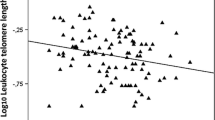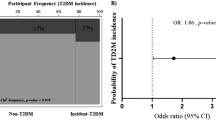Abstract
Previous evidences support that increased oxidative stress (OxS) may play an important role in metabolic syndrome (MetS) and both are closely linked to vascular dysfunction. This study determined whether there is a relationship between endothelial function and relative telomere length (RTL) in MetS subjects. In this cross-sectional study from the LIPGENE cohort, a total of 88 subjects (36 men and 52 women) were divided into four groups by quartiles of telomere length. We measured ischemic reactive hyperemia (IRH), total nitrite (NO) and protein carbonyl (PC) plasma levels, F2-isoprostanes urinary levels, and superoxide dismutase (SOD) and glutathione peroxidase (GPx) plasma activities. IRH and NO plasma levels were higher in subjects with longer RTL (quartiles 3 and 4), while PC plasma levels, F2-isoprostanes urinary levels, and GPx and SOD plasma activities were lower in quartile 4 subjects (longest RTL). Additionally, MetS subjects with longer RTL had greater homeostatic model assessment-β level and lower triglycerides plasma levels. Our results suggest that endothelial dysfunction, associated with high levels of OxS, could be entailed in an increment of telomere attrition. Thus, further support of the molecular and cellular mechanisms involved in vascular dysfunction may contribute to the development of strategies to decelerate vascular aging or prevent cardiovascular disease.



Similar content being viewed by others
References
(2001) Executive Summary of The Third Report of The National Cholesterol Education Program (NCEP) Expert Panel on detection, evaluation, and treatment of high blood cholesterol in adults (Adult Treatment Panel III). Jama 285(19): 2486-97
Armanios M (2013) Telomeres and age-related disease: how telomere biology informs clinical paradigms. J Clin Invest 123(3):996–1002
Basu S (2008) F2-isoprostanes in human health and diseases: from molecular mechanisms to clinical implications. Antioxid Redox Signal 10(8):1405–34
Bucolo G, David H (1973) Quantitative determination of serum triglycerides by the use of enzymes. Clin Chem 19(5):476–82
Cawthon RM (2002) Telomere measurement by quantitative PCR. Nucleic Acids Res 30(10):e47
Conwell LS, Trost SG et al (2004) Indexes of insulin resistance and secretion in obese children and adolescents: a validation study. Diabetes Care 27(2):314–9
Duvnjak L, Duvnjak M (2009) The metabolic syndrome—an ongoing story. J Physiol Pharmacol 60(Suppl 7):19–24
Epel ES, Blackburn EH et al (2004) Accelerated telomere shortening in response to life stress. Proc Natl Acad Sci U S A 101(49):17312–5
Fernandez JM, Da Silva-Grigoletto ME et al (2010) Pre-exercise intake of different carbohydrates modifies ischemic reactive hyperemia after a session of anaerobic, but not after aerobic exercise. J Strength Cond Res 24(6):1623–32
Ferroni P, Basili S et al (2006) Endothelial dysfunction and oxidative stress in arterial hypertension. Nutr Metab Cardiovasc Dis 16(3):222–33
Flohe L, Gunzler WA (1984) Assays of glutathione peroxidase. Methods Enzymol 105:114–21
Fujita K, Nishizawa H et al (2006) Systemic oxidative stress is associated with visceral fat accumulation and the metabolic syndrome. Circ J 70(11):1437–42
Guidelines, E. S. o. H.-E. S. o. C. and Committee (2003) 2003 European Society of Hypertension-European Society of Cardiology guidelines for the management of arterial hypertension. J Hypertens 21(6):1011–53
Harte AL, da Silva NF et al (2012) Telomere length attrition, a marker of biological senescence, is inversely correlated with triglycerides and cholesterol in South Asian males with type 2 diabetes mellitus. Exp Diabetes Res 2012:895185
Hastings R, Qureshi M et al (2004) Telomere attrition and accumulation of senescent cells in cultured human endothelial cells. Cell Prolif 37(4):317–24
Hopps E, Caimi G (2013) Protein oxidation in metabolic syndrome. Clin Invest Med 36(1):E1–8
Johnson F, Giulivi C (2005) Superoxide dismutases and their impact upon human health. Mol Aspects Med 26(4–5):340–52
Jones DP (2006) Extracellular redox state: refining the definition of oxidative stress in aging. Rejuvenation Res 9(2):169–81
Khan S, Chuturgoon AA et al (2012) Telomeres and atherosclerosis. Cardiovasc J Afr 23(10):563–71
Levine RL, Garland D et al (1990) Determination of carbonyl content in oxidatively modified proteins. Methods Enzymol 186:464–78
Marin C, Yubero-Serrano EM et al (2013) Endothelial aging associated with oxidative stress can be modulated by a healthy Mediterranean diet. Int J Mol Sci 14(5):8869–89
Matthews DR, Hosker JP et al (1985) Homeostasis model assessment: insulin resistance and beta-cell function from fasting plasma glucose and insulin concentrations in man. Diabetologia 28(7):412–9
McNeill AM, Rosamond WD et al (2005) The metabolic syndrome and 11-year risk of incident cardiovascular disease in the atherosclerosis risk in communities study. Diabetes Care 28(2):385–90
Nakashima H, Ozono R et al (2004) Telomere attrition in white blood cell correlating with cardiovascular damage. Hypertens Res 27(5):319–25
National Cholesterol Education Program (NCEP) Expert Panel on Detection E, a. T. o. H. B. C. i. A. A. T. P. I. (2002) Third Report of the National Cholesterol Education Program (NCEP) Expert Panel on Detection, Evaluation, and Treatment of High Blood Cholesterol in Adults (Adult Treatment Panel III) Final Report. Circulation 106 (25): 3143-421
Nebot C, Moutet M et al (1993) Spectrophotometric assay of superoxide dismutase activity based on the activated autoxidation of a tetracyclic catechol. Anal Biochem 214(2):442–51
O'Callaghan NJ, Fenech M (2011) A quantitative PCR method for measuring absolute telomere length. Biol Proced Online 13:3
Pena-Orihuela P, Camargo A. et al. (2013) Antioxidant system response is modified by dietary fat in adipose tissue of metabolic syndrome patients. J Nutr Biochem
Perez-Martinez P, Moreno-Conde M et al (2010) Dietary fat differentially influences regulatory endothelial function during the postprandial state in patients with metabolic syndrome: from the LIPGENE study. Atherosclerosis 209(2):533–8
Ray G, Husain SA (2002) Oxidants, antioxidants and carcinogenesis. Indian J Exp Biol 40(11):1213–32
Reaven G (2002) Metabolic syndrome: pathophysiology and implications for management of cardiovascular disease. Circulation 106(3):286–8
Ricart-Jane D, Llobera M et al (2002) Anticoagulants and other preanalytical factors interfere in plasma nitrate/nitrite quantification by the Griess method. Nitric Oxide 6(2):178–85
Rifai N, Tracy RP et al (1999) Clinical efficacy of an automated high-sensitivity C-reactive protein assay. Clin Chem 45(12):2136–41
Roberts LJ, Morrow JD (2000) Measurement of F(2)-isoprostanes as an index of oxidative stress in vivo. Free Radic Biol Med 28(4):505–13
Saliques S, Zeller M et al (2010) Telomere length and cardiovascular disease. Arch Cardiovasc Dis 103(8–9):454–9
Satoh M, Ishikawa Y et al (2008) Association between oxidative DNA damage and telomere shortening in circulating endothelial progenitor cells obtained from metabolic syndrome patients with coronary artery disease. Atherosclerosis 198(2):347–53
Tierney AC, McMonagle J et al (2011) Effects of dietary fat modification on insulin sensitivity and on other risk factors of the metabolic syndrome—LIPGENE: a European randomized dietary intervention study. Int J Obes (Lond) 35(6):800–9
Toda N (2012) Age-related changes in endothelial function and blood flow regulation. Pharmacol Ther 133(2):159–76
Tucker PS, Dalbo VJ et al (2013) Clinical and research markers of oxidative stress in chronic kidney disease. Biomarkers 18(2):103–15
Van Guilder GP, Hoetzer GL et al (2006) Influence of metabolic syndrome on biomarkers of oxidative stress and inflammation in obese adults. Obesity (Silver Spring) 14(12):2127–31
Warnick GR, Benderson J et al (1982) Dextran sulfate-Mg2+ precipitation procedure for quantitation of high-density-lipoprotein cholesterol. Clin Chem 28(6):1379–88
\Wilson WR, Herbert KE et al (2008) Blood leucocyte telomere DNA content predicts vascular telomere DNA content in humans with and without vascular disease. Eur Heart J 29(21):2689–94
Yubero-Serrano EM, Delgado-Lista J et al (2013) Oxidative stress is associated with the number of components of metabolic syndrome: LIPGENE study. Exp Mol Med 45:e28
Zhu H, Zhang L et al (2008) Coordinated upregulation of a series of endogenous antioxidants and phase 2 enzymes as a novel strategy for protecting renal tubular cells from oxidative and electrophilic stress. Exp Biol Med (Maywood) 233(6):753–65
Acknowledgments
This research was supported partly by grants from the Ministerio de Ciencia e Innovacion (AGL2006-01979, AGL2009-12270 to JL-M), (‘CB06/03/0047-CIBER Fisiopatologia de la Obesidad y Nutricion’ is an ISCIII grant awarded to FP-J), Consejeria de Innovacion, Ciencia y Empresa, Junta de Andalucia (P06-CTS-01425 and CVI-7450 to JL-M), and Consejeria de Salud, Junta de Andalucia (06/128, 07/43,
PI0193/2009 to JL-M, 06/129 to FP-J).
Author information
Authors and Affiliations
Corresponding author
Additional information
Lorena González-Guardia and Elena María Yubero-Serrano contributed equally to this work.
Electronic supplementary material
Below is the link to the electronic supplementary material.
About this article
Cite this article
González-Guardia, L., Yubero-Serrano, E.M., Rangel-Zuñiga, O. et al. Influence of endothelial dysfunction on telomere length in subjects with metabolic syndrome: LIPGENE study. AGE 36, 9681 (2014). https://doi.org/10.1007/s11357-014-9681-9
Received:
Accepted:
Published:
DOI: https://doi.org/10.1007/s11357-014-9681-9




